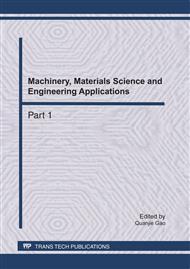[1]
Chen Liangji. Study on generation of 5-axis tool path and interpolation. Intellectual Property Publishing House. 2008. 1.
Google Scholar
[2]
Siemens AG. Function Manual: SINUMERIK 840D sl Special Functions, 2009. 03.
Google Scholar
[3]
Siemens AG. Milling with SINUMERIK: 5-axis machining manual, 2009. 05.
Google Scholar
[4]
Heidenhain AG. User's Manual: HEIDENHAIN Conversational iTNC 530, 2008. 12.
Google Scholar
[5]
FANUC LTD. FANUC Series 30i/31i/32i-Model A, 2009. 09.
Google Scholar
[6]
Syh-Shiuh Yeh, Pau-Lo Hsu. Adaptive-feedrate interpolation for parametric curves with a cofined chord error. Computer-Aided Design., Vol. 34(2002), pp.229-237.
DOI: 10.1016/s0010-4485(01)00082-3
Google Scholar
[7]
Sung-Ho Nam, Min-Yang Yang. A study on a generalized parametric interpolator with real-time jerk-limited acceleration. Computer-Aided Design. 36 (2004), pp.27-36.
DOI: 10.1016/s0010-4485(03)00066-6
Google Scholar
[8]
Yang DCH, Kong T. Parametric interpolator versus linear interpolator for precision CNC machining. Computer Aided Design. 26 (1994), pp.225-234.
DOI: 10.1016/0010-4485(94)90045-0
Google Scholar
[9]
Rida T. Farouki, Yi-Feng Tsai. Exact Taylor series coefficients for variable-feedrate CNC curve interpolators. Computer-Aided Design. 33 (2001), pp.155-265.
DOI: 10.1016/s0010-4485(00)00085-3
Google Scholar
[10]
M Munlin. S S Makhanov. E L J Bohez. Optimization of rotations of a five-axis milling machine near stationary points. 36 (2004), pp.1117-1128.
DOI: 10.1016/s0010-4485(03)00164-7
Google Scholar
[11]
S S Makhanov. M Munlin. Optimal sequencing of rotation angles for five-axis machining 35 (2007), pp.41-54.
DOI: 10.1007/s00170-006-0699-8
Google Scholar
[12]
Wu Yue, Wang Yuhan, Bi Qingzhen. Optimazition and Selection of Rotations of Five-axis Machining. Modular Machine Tool & Automatic Manufacturing Technique. 5 (2009), pp.1-5.
Google Scholar
[13]
Zhouji, Zhou yanhong. Technology of NC Machining. National Defense Industry Press. (2002).
Google Scholar
[14]
Wu Dazhong, Wang Yuhan, Feng Jingchun. Analysis and Control of the Non-linear Errors in Five-axis NC Machining. Journal of Shanghai Jiaotong University.
Google Scholar
[15]
Cábor Erdios, Matthias Müller, Paul Xirouschaksi. Parametric tool correction algorithm for 5-axis machining. Advanced in Engineering Software. 36 (2005), pp.364-663.
DOI: 10.1016/j.advengsoft.2005.03.013
Google Scholar


